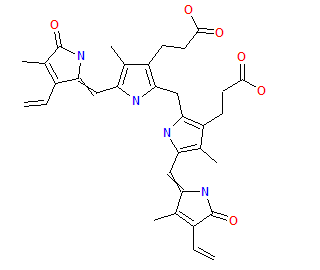Dubin-Johnson syndrome
Editor-In-Chief: C. Michael Gibson, M.S., M.D. [1]; Associate Editor(s)-in-Chief:
Please help WikiDoc by adding content here. It's easy! Click here to learn about editing.
Overview
Dubin-Johnson syndrome is an autosomal recessive disease which presents shortly after birth with an increase of conjugated bilirubin without elevation of liver enzymes (ALT, AST).
| Dubin-Johnson syndrome | |
 | |
|---|---|
| Bilirubin | |
| ICD-10 | E80.6 |
| ICD-9 | 277.4 |
| OMIM | 237500 |
| DiseasesDB | 3982 |
| eMedicine | med/588 |
| MeSH | D007566 |
Historical Perspective
Classification
Pathophysiology
Causes
Differentiating Dubin-Johnson syndrome from Other Diseases
Epidemiology and Demographics
Risk Factors
Screening
Natural History, Complications, and Prognosis
Natural History
Complications
Prognosis
Prognosis is good and there's no need to treat this syndrome.
Diagnosis
Diagnostic Criteria
History and Symptoms
Physical Examination
Laboratory Findings
Imaging Findings
Other Diagnostic Studies
Treatment
Medical Therapy
Surgery
Prevention
There is a lack of canalicular multi-drug resistant protein which causes dysfunction on bilirubin transfer to bile canaliculi.
An isoform of this protein is localized to the lateral hepatocyte membrane, allowing transport of glucuronide and glutathione conjugates back into the blood.
Analysis of urine pophyrins show a normal level of coproporphirin but the I isomer accounts for 80% ot the total(normally 25%)
Liver will present with dark brown appearance due to pigment accumulation.
See also
References
Template:Endocrine, nutritional and metabolic pathology